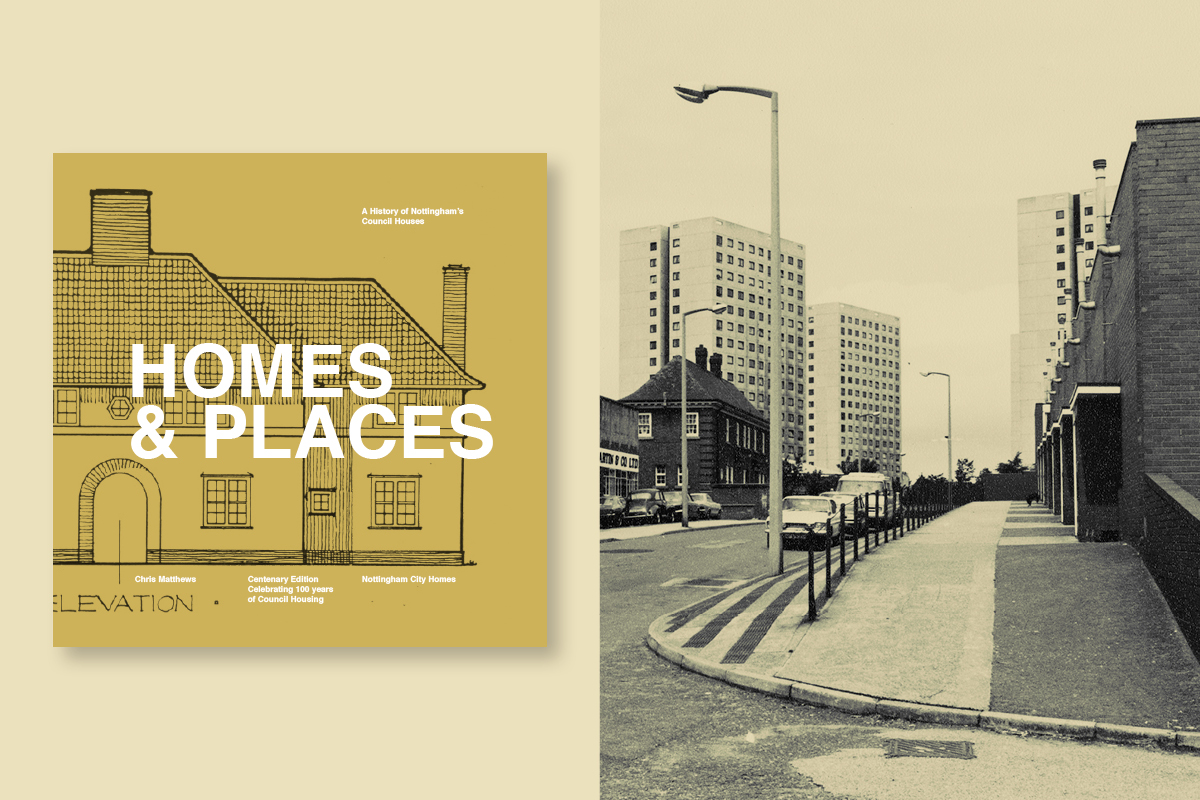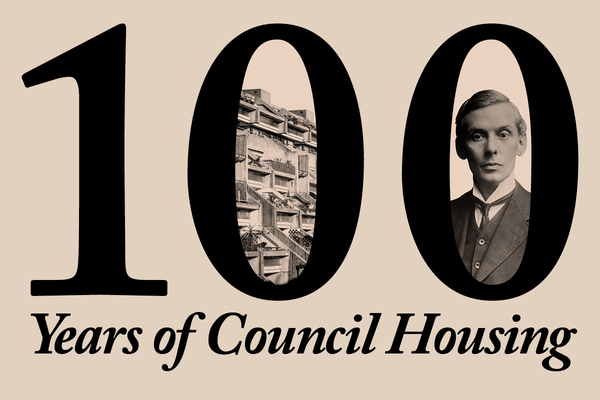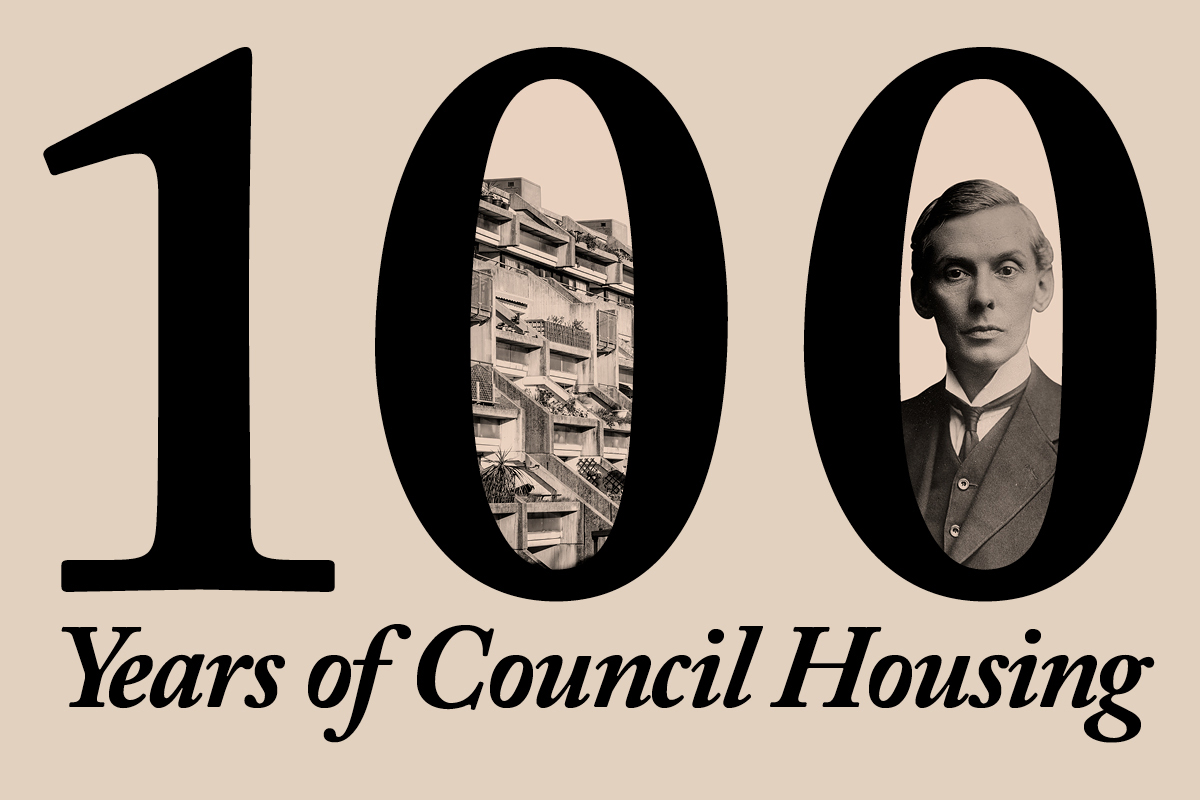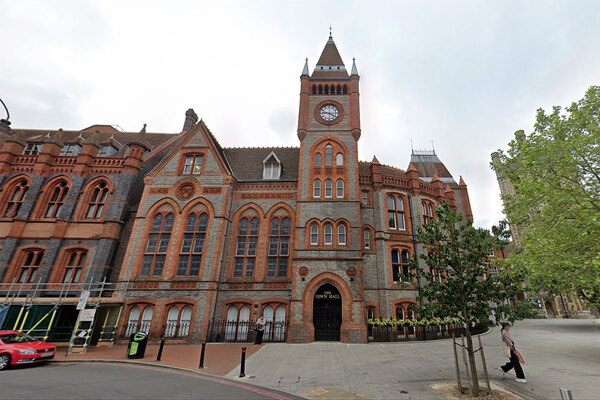You are viewing 1 of your 1 free articles
Council housing: the key to a more equitable and dynamic society
As the 100th anniversary of the Addison Act approaches, we publish an abridged extract of a book by Chris Matthews chronicling the history of council housing in Nottingham
Inside Housing is publishing a number of articles this month to mark the 100-year anniversary of the Addison Act, which paved the way for large-scale council housebuilding.
Below is an extract from Homes and Places: A History of Nottingham’s Council Houses, which has been updated this year to mark the anniversary of the Addison Act. It is published by Nottingham City Homes.
“Like the NHS, the social and economic value of council housing deserves to be embedded in government policy. The trauma of the First World War and the pioneering spirit of the 1919 Addison Act should not be forgotten.
Quite simply, the experience in Nottingham during the interwar period proves that council housing created an unprecedented collective leap in living standards.
Moreover, the recent activities of Nottingham City Homes and the Nottingham Business School show how this mode of housing, when delivered well, creates a virtuous cycle that benefits all.
The implementation of the ‘Secure Warm Modern’ Decent Homes Programme is a case in point. Indeed, a stronger case can be made for delivering council housing for general needs, as opposed to just those in greatest need.
For example, it is arguable that those council estates in Nottingham that were built for general needs, such as Wollaton Park, Sherwood, Bilborough and Clifton, were often among the most desirable and most cohesive, going on to be desirable communities that have remained sought after neighbourhoods.
It also appears that over the last fifty years central government has increasingly been criticised for failing to deliver on all that it has promised. Examples include the failed prefabricated housing schemes of the 1960s, and the difficulty many people have of being able to afford good housing after nearly forty years of policy designed to prioritise homeownership.
“Like the NHS, the social and economic value of council housing deserves to be embedded in government policy”
The perspective of history allows us to see alternatives to this arrangement. Britain led the way in municipal enterprise from the 1870s right up until the outbreak of the Second World War.
The municipal achievements in Nottingham during this period are a case in point. During the early 1920s the city successfully implemented the Addison Act and built many homes to the standards set by the Tudor Walters Report.
Local authorities can also be complicit in the errors of central government, but the quality of their ability to deliver is also dependant on their own clarity of direction.
For example, in Nottingham the William Crane era (1919–1957) offered greater certainty for the Housing Department than was experienced during the 1960s and 70s. Similarly, the Labour majorities of the 1990s until the present day have afforded confidence in long-term planning.
The Crane era has also bestowed us with another lesson: that architectural quality creates civic pride in social housing.
Although there are some notable exceptions, Nottingham did not compare favourably with the likes of Sheffield, Newcastle, Coventry, Southampton and the London Borough of Camden.
Unfortunately the city has little to compare with the likes of Alexandra Road Estate in London, or the Byker Wall in Newcastle. That said, the St Ann’s district heating scheme was very enterprising, while the design of the Meadows in the 1970s displayed good improvements in design by the Housing Department.
In some ways, a similar ambition has been applied by Nottingham City Homes to its energy sustainability schemes; such as those in the Broxtowe Estate, Clifton and Sneinton. With the necessity for green technologies likely to grow, it will be propitious for the city to be involved in their development.
More recently, the Lenton Green development has received recognition for design quality, and shows promise for the future of housing in Nottingham. Over the past 100 years, the tenants and citizens of Nottingham have taught us the value of bottom-up approaches and the need for greater flexibility when it comes to meeting the needs of its tenants.
“Most people are not dogmatic when it comes to their choice of tenure: homeownership is desirable for many, but so too is the option of renting from a social housing provider”
Some of these approaches were pioneered by housing associations from the 1970s and have been embraced by Nottingham City Homes.
Most people are not dogmatic when it comes to their choice of tenure: homeownership is desirable for many, but so too is the option of renting from a social housing provider.
Similarly, many residents prefer to live in the busy inner city, while others prefer the relative quiet of the suburban estates. This brings us to a final point on the planning and future development of the city’s council housing: if the population is projected to continue growing, then how can the city meet its housing needs?
If further suburban council estates are built within the green belt for example, then the experiences of the 1930s in Broxtowe and 1950s in Clifton emphasise the importance of public transport connections and amenities such as shops and schools.
But as in the 1960s, will the inefficiencies of greenfield development be questioned? Will we have to return to the inner-city schemes that were so derided by the 1980s?
England, and not just Nottingham, has an uneasy history with such ideas. The difficult experience with Victoria buildings was a huge setback for the council in the 1870s, while William Crane disapproved of tenements throughout his leadership.
Yet the evidence suggests that when done well, high-density housing can be highly successful.
In Nottingham the successful recent refurbishments of high-rise flats and maisonettes may be pointing to the future.
In Britain there has been a great deal of pride and symbolism to commemorate the events of 1914–1918.
More could have been made of its causes and consequences, particularly the social unrest and economic uncertainty of the immediate years.
This was a climate of economic dislocation, unemployment, strikes, influenza, inflation, poor housing, cynicism and the exhaustion of liberal democracy.
Some failed to grasp that the war had been a revolution and that a ‘return to normality’ would prove delusional. Yet others also understood the need for a new interventionist approach: government departments became ministries where experts shaped policy and new areas of official encouragement guided science and industry.
The Unemployment Insurance Acts confirmed the social obligation of welfare, the political franchise became more equitable and the 1919 Addison Act established housing as ‘a social problem to be tackled on a national scale by getting houses built’.
Over the following 100 years Nottingham’s experience demonstrated areas where this approach succeeded and where mistakes were made.
More importantly, it shows that council housing is key to a more equitable, resilient and dynamic society. Its contribution towards a modern civil society is of the utmost significance.”
Chris Matthews, author, Homes and Places: A History of Nottingham’s Council Houses
Homes & Places is available now from Five Leaves Bookshop
100 Years of Council Housing: we want to hear from you
To mark the 100th anniversary of the act receiving Royal Assent in July, we have a month of special activities planned, including interviews with senior council housing figures, exclusive debate and comment, and investigations into what local authorities, past and present, are doing to help provide housing.
This will signal the start of a stronger focus on local authority housing issues over the coming months on www.insidehousing.co.uk and in our weekly print and digital editions.
We want to hear from you about your local authority is doing to mark the Addison Act and about the housing issues in your area, email: editorial@insidehousing.co.uk
Sign up to receive the latest housing news straight to your inbox through our exclusive Council Focus bulletin
If you are already a subscriber click here to manage your newsletter sign-ups
Click here to read more about our activity to mark the Addison Act
100 Years of Council Housing: what Inside Housing is doing
One hundred years ago, a piece of legislation led to the birth of council housing. Gavriel Hollander introduces Inside Housing’s celebration of the centenary of the Addison Act.
It is so ingrained in our national consciousness that it is hard to imagine just how radical the idea of local authority built and funded housing must have seemed a century ago. Before World War I, almost all housing in the UK was built by private developers (albeit with some notable municipal exceptions in major cities). Given this, it is unsurprising that both quality and consistency of delivery were variable.
The post-war introduction of subsidies for councils to solve the blight of slum estates was supposed to right a wrong and – in the words of then-prime minister David Lloyd George – provide “homes fit for heroes”.
The so-called Addison Act – the very first housing act passed in this country, named after its sponsor Dr (later Lord) Christopher Addison – received royal assent exactly 100 years ago this month.
It may never have achieved its aspiration of delivering 500,000 homes (something that may sound familiar to modern-day watchers of government housing policy) but it was the start of a movement.
New estates began to crop up across the country, built in accordance with recommendations from the Tudor Walters Report, which was produced to parliament in November 1918. This built on the ‘Garden City Principles’ and suggested a number of improvements to the standard of public housing. These included limiting the length of terraced-housing blocks, mandating a minimum number of rooms and providing indoor bathrooms.
“The post-war introduction of subsidies for councils to solve the blight of slum estates was supposed to right a wrong and – in the words of the prime minister David Lloyd George – provide ‘homes fit for heroes’”
Although the abandonment of subsidy in 1921 and a change of government the following year curtailed the immediate growth of council-built housing, the seed had been sown.
This month Inside Housing celebrates the centenary of the Addison Act with a month-long series of articles looking at how it transformed the social fabric of the country and created the housing sector we know today.
Over the course of this month, we visit four estates, each symbolising a different era of council housebuilding. We also take a look at whether new-found financial freedom for local authorities could be the catalyst for a new generation of estates.
To kick off the series, acclaimed social historian John Boughton visits one of the first estates made possible by Lord Addison’s historic legislation: Sea Mills in Bristol. We then travel to Stevenage to look at how the damage to Britain’s inner cities during the Blitz led to the new town movement and a fresh wave of estates through the 1950s and 1960s.
Martin Hilditch, editor of Inside Housing, takes a trip to Hulme in Manchester to examine how the private and public sector had to work together in the 1980s to deliver a regeneration project, which is still thriving more than 30 years later.
Finally, we go to Nottingham and look at one council with grand ambitions to provide housing to a new generation of tenants.
There may still be myriad challenges to face when it comes to providing good-quality, genuinely affordable housing for those most in need, but without the passing of an act of parliament 100 years ago, the sector we work in today may never have come to exist. That alone is worth celebrating.
To read more about the act, go to: www.insidehousing.co.uk/AddisonAct
More on the Addison Act
How George Clarke is aiming to end the housing crisis with his new TV show Architect George Clarke has long been a passionate campaigner for more – and better – council housing. As Inside Housing celebrates 100 years of the Addison Act, Martin Hilditch meets a man on a mission
100 Years of Council Housing: your tweets from week three Our favourite #100yearsofcouncilhousing tweets from the past seven days as our Addison Act activity moves into its fourth week
Nottingham's new wave Robyn Wilson goes to Nottingham to see what the next generation of council homes are set to look like.
If we’re going to have another 100 years of council housing, Right to Buy has to go The Right to Buy is having a devastating effect on the availability of council housing in this country and must be scrapped, writes Lee Sugden
What next for council housing? To celebrate the centenary of the Addison Act, Inside Housing asks a group of housing experts what can be learned from its legacy (sponsored)
Thatcher's legacy: a brief history of the Right to Buy An engine for social change or a handbrake on council development? We look at why the Right to Buy is as divisive as ever #ukhousing
A history of council housing: a timeline From the Addison Act to prefabs, slum clearance and the Right to Buy, council housing in the United Kingdom has a long and colourful history. Carl Brown looks at how it has evolved over time
Council housing: the key to a more equitable and dynamic society As the 100th anniversary of the Addison Act approaches, we publish an abridged extract of a book by Chris Matthews chronicling the history of council housing in Nottingham
Addison’s framework was scrapped but its legacy is more important than ever The fortunes of council housing have ebbed and flowed ever since Addison’s programme was abruptly halted in 1921, writes Jules Birch
Hulme: the redevelopment project that changed regeneration The redevelopment of Hulme in Manchester kick-started a new approach to regeneration in the UK – and the careers of some of housing’s best-known figures. Martin Hilditch joins them on a step back in time with lessons for today.
100 Years of Council Housing: your tweets from week two We pick our favourite #100yearsofcouncil housing tweets over the past week
Memories of council housing: the human legacy of the Addison Act As the centenary of the first council houses approaches, Peter Apps hears from some of the people who have lived in them in the decades since
Many of the sector’s current leaders began their journeys in council teams One hundred years of council housing has delivered a generation of sector leaders as well as millions of council homes, writes Mervyn Jones
Stevenage: home of the new town revolution Stevenage was the first of the post-war ‘new towns’. Gavriel Hollander visits the town to see how it has changed.
100 Years of Council Housing: your tweets from week one Inside Housing has been encouraging councils to say what they are doing to build homes and to mark 100 years of council housing. Here we feature a selection of your tweets
Kit Malthouse: 'Council housing is coming back with a vengeance' Housing minister Kit Malthouse tells Martin Hilditch why growing numbers of councils are looking to get back into development
Sea Mills: we visit one of the first estates to benefit from the Addison Act Social historian John Boughton visits a place in Bristol still cherished today
The Housing Podcast: is council housebuilding about to make a comeback Nearly 100 years after the introduction of the Addison Act, which kick-started the building of the first council estates in the UK, the Housing Podcast team examines the state of council housebuilding today
Why the 100th anniversary of the Addison Act should spark a council housing comeback Let’s make 2019 the start of a renaissance of council housing, writes Martin Hilditch
Are new borrowing freedoms sparking a revival of council housebuilding? The Addison Act marked the birth of council housebuilding. A century later, could recent financial freedom spark a renaissance? Nathaniel Barker investigates.
How Cornwall is taking inspiration from Christopher Addison Cornwall Council is one of many keeping the legacy alive, writes Kate Kennally.
The Addison Act - celebrating 100 years of council housing This year marks the 100th anniversary of the Addison Act – which paved the way for council housebuilding on a large scale. Inside Housing has a whole month of special activity planned and we want to hear your stories
The 100-year anniversary of the Addison Act means it’s time to talk about council housing Let’s use the 100th anniversary of council housing as we know it to flag up some of the great work that’s been done – and kick-start a conversation about the future, writes Martin Hilditch
London must recapture the housebuilding ambition of the Addison Act Councils are committed to development but are still facing unfair restrictions, writes Darren Rodwell of London Councils
Marking 100 years since the ‘Addison Act’ Professor Mark Swenarton writes about the Homes Fit for Heroes Centenary Conference
More council news
Council tenants on Universal Credit 16 times more likely to abandon tenancies
Council to claw back 260 Right to Buy homes
Local authorities accuse government of ‘sleight of hand’ over post-Hackitt regulation
Partner with housing associations to use borrowing freedoms, says LGA chair
Bristol City Council signs off partnership with L&G for 500-home scheme
Council boss warns against local authority ‘can't do’ attitude towards housebuilding
Right to Buy sales plummet 23%
Supreme Court rules against Birmingham Council in homelessness case
A bed every night: has Manchester's mayor succeeded in helping every rough sleeper in the city?
Council housing company to offer Rent to Buy
Council-owned regeneration company to build 500 homes
How has Haringey Council moved on from its development vehicle fight?
Liverpool to open HRA to build new council homes for first time in 30 years
How can London councils build more homes?
Birmingham Council’s housing company to build 2,708 homes by 2029
How are councils are using pension funds to build homes














